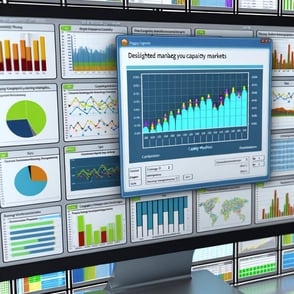Day Ahead Market
The Day-Ahead Market is a platform where electricity is traded a day before delivery, allowing participants to secure prices and quantities in advance, thereby balancing supply and demand.
What is the Day-Ahead Market?
The Day-Ahead Market is a vital platform where electricity is traded a day before it is delivered. This market allows participants to secure prices and quantities for the next day's electricity needs, helping to balance supply with demand. It serves as a tool for efficient planning and optimization of the electricity grid. By enabling trades a day in advance, the Day-Ahead Market provides a mechanism for managing the fluctuating nature of electricity supply and demand, which is crucial for maintaining grid stability.
The Purpose of the Day-Ahead Market
The primary purpose of the Day-Ahead Market is to offer a structured environment for electricity trading that occurs one day before the actual delivery. This preemptive trading allows market participants to lock in prices and quantities, facilitating planning. This market plays a significant role in grid operations by helping to balance the anticipated supply and demand for electricity. It also delivers essential price signals that guide market participants in their trading decisions.
In the context of liberalized power markets, various players, including proprietary traders, utilities, industrial consumers, and large producers need to balance their electricity production and/or consumption. These players manage their electricity needs through balancing groups, where they must ensure that the total amount of electricity bought and sold matches. While futures markets help with long-term hedging strategies, the Day-Ahead Market addresses more immediate needs as the delivery day approaches. For instance, a trader might sell surplus electricity generated by a wind farm on the Day-Ahead Market to balance the electricity forecasted for the following day. If unforeseen conditions lead to additional surplus, the intraday continuous market and the intraday auction market serve as a venue for further adjustments.
How the Day-Ahead Market Operates
The Day-Ahead Market operates through a daily auction where electricity is traded for every hour of the following day. This auction follows a specific procedure to determine the market clearing price (MCP), which is the price at which the amount of electricity demanded equals the amount supplied.
Participants in the Day-Ahead Market submit their buy and sell orders before the auction closes. These orders specify the volume of electricity and the prices participants are willing to accept or offer. Once the order book is closed, a market algorithm processes these orders to create a demand curve from the buy orders and a supply curve from the sell orders. The intersection of these curves establishes the MCP for each hour of the next day.
The auction's outcome results in legally binding agreements where buyers and sellers transact electricity at the MCP. This price represents the equilibrium point where supply meets demand, ensuring that all transactions occur at a uniform price for each hour. Participants who submitted higher bids pay the MCP, while those who offered lower prices receive it. The auction mechanism facilitates liquidity and transparency, providing a level playing field for all participants.
Price Formation in the Day-Ahead Market
Electricity prices in the Day-Ahead Market are determined by a marginal cost pricing system. This pricing method ensures that the electricity is provided at the lowest possible cost by considering the marginal production costs of power plants.
In this system, power plants are ordered from least to most expensive based on their marginal costs, which are the costs associated with producing an additional unit of electricity. The price for all electricity traded is set by the last power plant activated to meet the demand, which generally has the highest marginal cost. This ensures that electricity demand is met at the lowest possible cost while providing all generators with the opportunity to cover their operational expenses.

Moreover, the cost of generating electricity is influenced by CO2 emission certificates in Europe. These certificates create a connection between electricity pricing and the cost of CO2 emissions, affecting the costs associated with using fossil fuels like coal and gas.
The Impact of the Day-Ahead Market
The Day-Ahead Market plays several crucial roles in the power system. It helps to balance supply and demand, promotes efficient market operations, and provides valuable price signals to market participants. By allowing participants to plan and trade electricity for the next day, the Day-Ahead Market supports grid reliability and efficiency.
In essence, the Day-Ahead Market ensures that electricity production and consumption are in harmony, promoting stability in the power grid. This market mechanism also encourages efficient electricity generation by ensuring that the least expensive sources of power are used first and that all generators are able to cover their costs.
Conclusion
The Day-Ahead Market is a sophisticated and essential component of the electricity grid's operation. It functions like a daily reservation system for electricity, where participants trade power for the next day, balancing supply with demand and stabilizing prices. Through its auction process and marginal cost pricing system, the DAM ensures that electricity is produced and consumed efficiently, maintaining a reliable and cost-effective power supply.
Understanding the Day-Ahead Market provides insight into how the complex systems of the electricity grid work together to keep the lights on and support economic activity.
Glossary
- Bid: An offer to buy electricity at a specific price.
- Offer: An offer to sell electricity at a specific price.
- Market Clearing Price: The price at which supply matches demand.
- Uniform Price Auction: An auction where all accepted bids and offers settle at the same price.
- Hourly Contracts: Contracts for delivery each hour of the next day.
- Block Contracts: Contracts for delivery over multiple consecutive hours.
- Nominated Electricity Market Operator (NEMO): Entity responsible for operating day-ahead and intraday integrated electricity markets within the EU.
- Capacity Allocation and Congestion Management (CACM): Regulation establishing rules for EU-wide single market coupling.
- Balance Responsible Party (BRP): Entity responsible for balancing supply and demand within a specific area or portfolio.
- Euphemia: The algorithm used in the PCR project to calculate energy allocation and electricity prices across Europe.
- Economic Surplus: The sum of consumer surplus, producer surplus, and congestion rent.
- Congestion Rent: Revenue generated from the allocation of scarce transmission capacity.
- Power Exchange (PX): A marketplace for buying and selling electricity.
- Implicit Auction: A market mechanism where energy and transmission capacity are allocated simultaneously.
- Transmission System Operator (TSO): Entity responsible for transporting electricity through the high-voltage power grid.
- Market Coupling (MC): The process of integrating different market areas to allow cross-border transactions without the need for separate transmission capacity rights.
.png?width=200&height=80&name=etpa-logo-color%20(1).png)











.png)
.png)
-1.png?width=250&height=100&name=etpa-logo-color%20(1)-1.png)